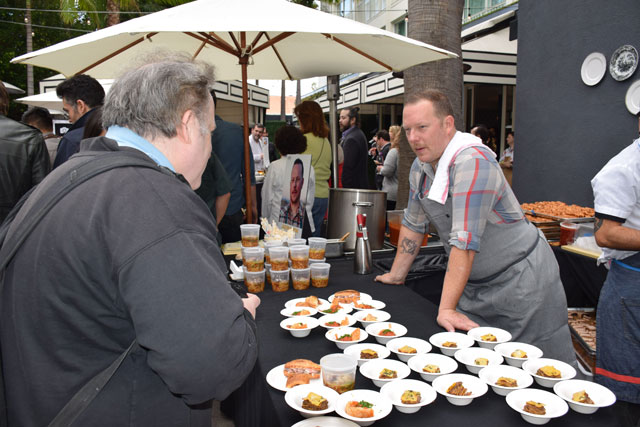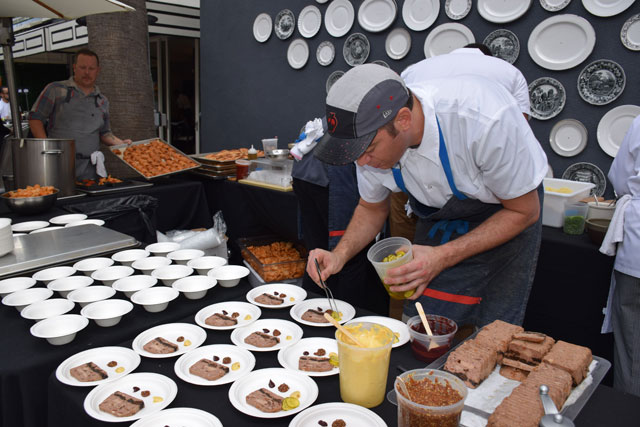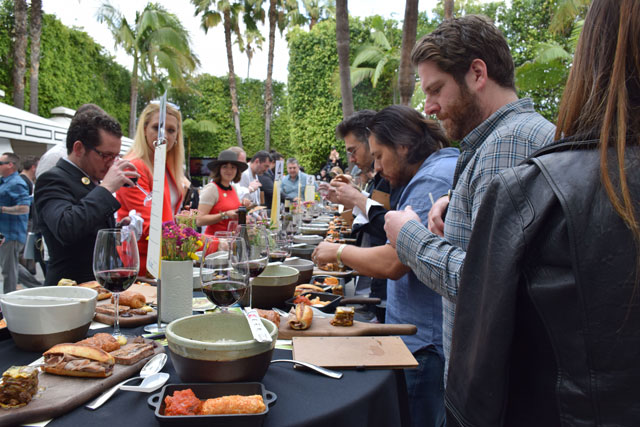(Photo: John Anthony Rizo/Getty Images)
“My family and I would love to indulge occasionally in good-quality bacon, sausages, hot dogs, and other cured meats, but I worry about the nitrites. Aren’t they dangerous?”
—Caleb James
To get a handle on nitrites, it helps to understand the role salting plays in curing meats. In On Food and Cooking, food scientist Harold McGee writes that salting, like drying, preserves meat by depriving bacteria and molds of water. “The addition of salt—sodium chloride—to meat creates such a high concentration of dissolved sodium and chloride ions outside the microbes that the water inside their cells is drawn out, salt is drawn in, and their cellular machinery is disrupted. The microbes either die or slow down drastically.” Chemistry is inherently operatic, when you think about it.
Other salts, such as those found in rocks, water, and even vegetables (hold that thought!), also play a critical role in curing meats. One of them, potassium nitrate, has been pressed into service for a very long time. Potassium nitrate’s common name is saltpeter (from sal and petra, the Latin words for “salt” and “rock”) because early food preservers scraped the saltlike crystalline substance off the nearest boulder to preserve their kill with. It wasn’t until around 1900 that scientists discovered that certain salt-tolerant microorganisms transform a small portion of nitrate into nitrite, which, in a genuine aha moment, turned out to be the true active curing agent. Once this was known, McGee explains, producers could replace saltpeter in the curing mixture with much smaller doses of pure nitrite. This is now the rule except when it comes to traditional dry-cured hams, for example, “where prolonged ripening benefits from the ongoing bacterial production of nitrite from nitrate.”
The use of nitrite remains an integral part of traditional curing methods for several reasons:
• It reacts in the meat to form nitric oxide, which binds to the iron atom in the red pigment myoglobin and prevents the iron from causing the fat to oxidize. That binding also produces the rosy pink-red color of cured meats—what we’ve been used to aesthetically since about the 10th century, when the Romans began adding saltpeter to meat to obtain that desired color.
• In terms of flavor, it contributes a characteristic sharpness that keeps evolving; a country ham aged for 18 months, for instance, has had time to develop a deep, resonant whang. And because nitrite is a powerful antioxidant, it helps keep the flavor of cured meats vibrant and free from off-flavors.
• Nitrite also squashes a variety of pathogens, including, most important, Clostridium botulinum, the bacterium that can cause rare but deadly botulism. Botulus is a Latin word for “sausage,” by the way, and the bacterium came by its name from its pathological association with Wurstvergiftung, or “sausage poisoning,” first investigated in the late 18th century in Germany.
But if you’re worried about consuming these preserving agents, let me break this to you as gently as I can: Even if you wouldn’t touch a ham sandwich, pepperoni pizza, or salumi plate with a 10-foot pole, you can no more avoid nitrate and nitrite than fly to the moon. According to sources such as “Human safety controversies surrounding nitrate and nitrite in the diet,” published in the journal Nitric Oxide: Biology and Chemistry, our saliva, surprisingly, “accounts for approximately 93.0% of the total daily ingestion of nitrite while foods account for a very small portion of the overall daily nitrite intake. This is due to the chemical reduction of salivary nitrate to nitrite by commensal bacteria in the oral cavity.” Forget cured meats; if you’re really concerned about nitrite, better stop swallowing.
Or, for that matter, eating vegetables, which contain the largest component (about 87 percent) of our dietary intake of nitrate. Those with the highest levels of nitrate are red beets, spinach, radishes, celery, lettuce, cabbage, fennel, broccoli, cucumbers, and leeks. If you’re interested in diving deeper, check out “Nitrate in vegetables,” a report by the Scientific Panel on Contaminants in the Food Chain of the European Food Safety Authority published in the EFSA Journal. I don’t imagine nitrate smoothies are going to be labeled as such at juice bars anytime soon, but optimizing the nitrate content in beet juice is of great interest to athletes and sports nutritionists.
While we’re on the subject of vegetables, let’s take a moment to contemplate “nitrite-free” bacon, hot dogs, etc. If you read the packages carefully, you’ll notice that what they actually say is “no nitrates or nitrites added.” Big difference in meaning there. What the producers use instead is celery powder or celery juice, both concentrated sources of nitrate, which is converted to nitrite by a bacterial culture.
An organic or natural hot dog may contain better-quality meat, but it also may contain just as much nitrate/nitrite or more as your everyday ballpark frank. In a 2011 business piece for The New York Times, William Neuman cited a study published in the Journal of Food Protection that year, which “found that natural hot dogs had anywhere from one-half to 10 times the amount of nitrite than conventional hot dogs contained. Natural bacon had from about a third as much nitrite as a conventional brand to more than twice as much.” Meat producers don’t have it easy in this case; truly nitrite-free products routinely fail in the marketplace because consumers don’t like them—people are accustomed to the color and flavor that comes with the curing process. But it’s high time the USDA took a fresh look at what is one heck of a confusing labeling issue.
So what makes nitrate and nitrite so controversial in the first place? In large enough amounts they are indeed toxic, the way anything is, even water. The main toxic effect is methemoglobinemia, a rare (and reversible) condition. Accidental poisonings aside, you would have to ingest thousands of hot dogs at a single sitting in order to overdose. The most eaten by Joey Chestnut, who won his eighth Nathan’s Hot Dog Eating Contest this year, is 61.
But cancer, of course, is everyone’s main concern. The potential of nitrate/nitrite to form carcinogenic N-nitrosamines in cured meats was first identified in 1971, according to the historical summary in the Nitric Oxide article mentioned above. “Their formation can take place only under special conditions where secondary amines are present, nitrite is available to react, near neutral pH is found, and product temperatures reach greater than 130°C, such as during the frying of bacon.”
The resulting shit show—er, groundswell of public concern—led to new regulations that lowered the amount of added nitrites, and new production practices were implemented. Among those practices was the addition of ascorbic acid (aka vitamin C, sodium ascorbate, erythorbic acid, sodium erythorbate), which inhibits the chemical reaction that can lead to the formation of nitrosamines. Additional limits exist for bacon: Nitrate is not permitted, so that actual concentrations of nitrite can be more precisely controlled; it’s also required to have either 550 parts per million added sodium erythorbate or sodium ascorbate, regardless of curing method, to inhibit the potential for nitrosamine formation during frying.
In a 2009 nationwide survey of cured meats and vegetables, it was “concluded that consistently lower levels of residual nitrate and nitrite than those from a survey reported by the National Academy of Sciences in 1981 existed.”
“Residual nitrite levels of 7 ppm in cooked sausages (hot dogs), 7 ppm in bacon, and 7 ppm in hams which have fallen from 10–31 ppm, 12–42 ppm, and 16–37 ppm, respectively, when compared to data reported in the NAS study,” the study continued. Overall, the survey found a nearly 80 percent reduction in nitrite levels in food products between 1975 and 2009. “Based on this data,” the authors write, “it can be concluded that cured meats provide minimal contributions to the human intake amounts of nitrate and nitrite.”
Interestingly, the Nitric Oxide piece also points out that in the 1990s, a new consumer product containing nitrate was introduced. “Toothpaste for sensitive teeth is now common and contains high levels (5% or 50,000 ppm (mg/kg)) of potassium nitrate. While under FDA regulatory purview, this newer source of human exposure has had no public controversy which is an interesting social question considering the debate concerning cured meats and the known salivary reduction of nitrate to nitrite.”
The advice to avoid cured meats because of possible risks related to cancer continues to resurface periodically. But since 1981, when the National Academy of Sciences first examined the scientific literature and concluded there was no link between nitrate/nitrite consumption and human cancers, there have been hundreds of studies that have examined the potential health risks. Aside from a few studies with demonstrably weak epidemiological data, the vast majority of studies have found no link.
Although research has failed to prove that nitrate or nitrite causes cancer, it has turned up a number of intriguing health benefits and possible pharmacological roles. The nitrites in our saliva, for example, seem to help protect us against foodborne pathogens and stomach ailments. And nitric oxide—the stuff that fixes the color in cured meats—has been found to be a signaling molecule, telling arteries when to expand (thus regulating blood pressure) and immune cells when to kill bacteria, and it helps brain cells communicate with one another. A lack of nitric oxide production in our bodies can lead to all sorts of unfortunate consequences, including hypertension, atherosclerosis, and thrombosis resulting in heart attack and stroke. The significance of this was of such paramount importance that the 1998 Nobel Prize in Physiology or Medicine was awarded to three American scientists for its discovery. I like to think they celebrated with a weenie roast.
Read the original post: http://www.takepart.com/










